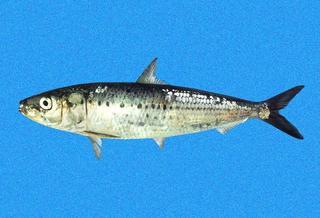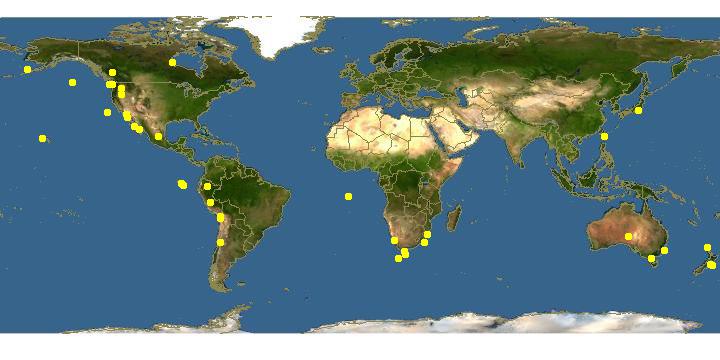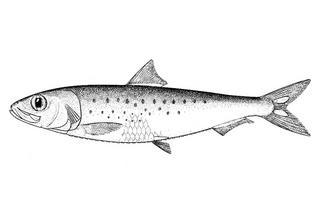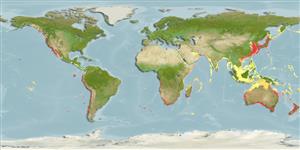|
| Links |
We parsed the following live from the Web into this page. Such content is managed by its original site and not cached on Discover Life. Please send feedback and corrections directly to the source. See original regarding copyrights and terms of use.
- Australian Faunal Directory
- FishBase
|
|
español |
|
|
Overview | |
Main identification features
Californian & Peruvian pilchard
Dorsal rays 14; anal rays 17; body cylindrical, slender, its depth 4.5- 5.0 in standard length; lower half of gill cover with distinct bony ridges radiating downward; mouth at front, relatively large, upper jaw reaching to below middle of eye; ridge of keeled scales along belly.
Blue on back, silvery on sides, and white on belly; widely scattered blackish spots on side.
Size: grows to about 41 cm.
Depth: 0-200 m.
Habitat: pelagic in coastal waters.
In the north from Alaska to Gulf of California, and the Revillagigedos; in the south from southern Ecuador to Chile, and Malpelo and the Galapagos.
A recent genetic analysis (Grant et al 1998) of the status of Sardinops populations indicates that there are three subspecies: S. s. ocellatus from south Africa, Australia and New Zealand, S. s. sagax from the southern and northern eastern Pacific, and S. s. melanostictus from the northwest Pacific.
Attributes
Abundance: Common.
Cites: Not listed.
Climate Zone: North Temperate (Californian Province &/or Northern Gulf of California); Northern Subtropical (Cortez Province + Sinaloan Gap); Northern Tropical (Mexican Province to Nicaragua + Revillagigedos); Equatorial (Costa Rica to Ecuador + Galapagos, Clipperton, Cocos, Malpelo); South Temperate (Peruvian Province ); Antitropical (North and South temperate).
Depth Range Max: 200 m.
Depth Range Min: 0 m.
Diet: zooplankton; pelagic fish larvae; Pelagic crustacea.
Eastern Pacific Range: Northern limit=57; Southern limit=-23; Western limit=-136; Eastern limit=-70; Latitudinal range=80; Longitudinal range=66.
Egg Type: Pelagic; Pelagic larva.
Feeding Group: Planktivore.
FishBase Habitat: Pelagic.
Global Endemism: TEP non-endemic; East Pacific endemic; All species.
Habitat: Water column.
Inshore Offshore: Inshore; Inshore Only.
IUCN Red List: Not evaluated / Listed.
Length Max: 41 cm.
Regional Endemism: Island (s); Continent; Temperate Eastern Pacific, primarily; Continent + Island (s); Tropical Eastern Pacific (TEP) non-endemic; California + Peruvian provinces, primarily; All species.
Residency: Vagrant.
Salinity: Marine; Marine Only.
Water Column Position: Near Surface; Surface; Water column only;
|
|
|
Names | |
|
|
|
Links to other sites | |
|
|
|
References |
- Balart , E. F. , Castro-Aguirre , J. L. and De Lachica-Bonilla, F., 1997., Análisis comparativo de las comunidades ícticas de fondos blandos y someros de la Bahía de La Paz, B.C. S.. En Urbán Ramírez, J. y M. Ramírez Rodríguez (Eds.). La Bahía de La Paz investigación y conservación., Universidad Autónoma de Baja California Sur:177-188.
- Béarez, P., 1996., Lista de los Peces Marinos del Ecuador Continental., Revista de Biologia Tropical, 44:731-741.
- Castro-Aguirre , J. L. and Balart, E. F., 1997., Contribución al conocimiento de la ictiofauna de fondos blandos y someros de la Ensenada de La Paz y Bahía de La Paz, B.C.S.. En Urbán Ramírez, J. y M. Ramírez Rodríguez (Eds.). La Bahía de La Paz investigación y conservación., Universidad Autónoma de Baja California Sur:139-150.
- Castro-Aguirre, J.L. and Balart, E.F., 2002., La ictiofauna de las islas Revillagigedos y sus relaciones zoogeograficas, con comentarios acerca de su origen y evolucion. En: Lozano-Vilano, M. L. (Ed.). Libro Jubilar en Honor al Dr. Salvador Contreras Balderas., Universidad Autonoma de Nuevo León:153-170.
- De la Cruz , J. , Galvan , F. , Abitia , L. A. , Rodriguez , J. and Gutierrez, F. J., 1994., Lista sistematica de los peces marinos de Bahia Magdalena, Baja California Sur (Mexico). Systematic List of marine fishes from Bahia Magdalena, Baja California Sur (Mexico)., Ciencias Marinas, 20:17-31.
- Eschmeyer , W. N. , Herald , E. S. and Hamman, H., 1983., A field guide to Pacific coast fishes of North America from the Gulf of Alaska to Baja California. Peterson Field Guide Ser. 28., Houghton Mifflin:336pp.
- Findley, L.T., Hendrickx, M.E., Brusca, R.C., van der Heiden, A.M., Hastings, P.A., Torre, J., 2003., Diversidad de la Macrofauna Marina del Golfo de California, Mexico., CD-ROM versión 1.0. Projecto de la Macrofauna del Golfo . Derechos reservados de los autores y Conservación Internacional.
- Galván-Magaña, F., Abitia-Cárdenas, L.A., Rodríguez-Romero, J., Pérez-España, H., Chávez-Ramos, H., 1996., Systematics list of the fishes from Cerralvo island, Baja California Sur, Mexico., Ciencias Marinas, 22:295-311.
- Galván-Magaña, F., Gutiérrez-Sánchez, F., Abitia-Cárdenas, L.A., Rodríguez-Romero, J., 2000., The distribution and affinities of the shore fishes of the Baja California Sur lagoons. In Aquatic Ecosystems of Mexico: Status and Scope. Eds. M. Manuwar, S.G. Lawrence, I.F. Manuwar & D.F. Malley. Ecovision World Monograph Series., Backhuys Publishers:383-398.
- González Navarro , E. and Saldierna Martínez, R., 1997., Zooplancton de la Bahía de La Paz, B.C.S. (1990-1991). En Urbán Ramírez, J. y M. Ramírez Rodríguez (Eds.). La Bahía de La Paz investigación y conservación., Universidad Autónoma de Baja California Sur:43-58.
- Grant , W. S. , Clark , A. -M. and Bowen, B. W., 1998., Why restriction fragment length polymorphism analysis of mitochondrial DNA failed to resolve sardine (Sardinops) biogeography: Insights from mitochondrial DNA cytochrome b sequences., Can. J. Fish Aquatic. Sci., 55:2539-2547.
- Grant , W. S. and Bowen, B. W., 1998., Shallow population histories in deep evolutionary lineages of marine fishes: Insights from sardines and anchovies and lessons for conservation., Journal of Heredity, 89:415-426.
- Hildebrand, S.F., 1946., A descriptive catalog of the shore fishes of Peru., Bull. U.S. Nat. Mus., 189:1-530.
- Jenyns, L., 1842., Fish. In: C. Darwin, ed. The zoology of the voyage of H.M.S. 'Beagle' under the command of Captain Fitzroy, R.N. during the years 1832 to 1836. Issued in 4 parts., Smith, Elder & Co.:i-xvi + 1-172.
- Jimenez-Prado, P., Béarez, P., 2004., Peces marinos del Ecuador continental / Marine fishes of continental Ecuador., SIMBIOE/NAZCA/IFEA tomo 1 y 2.
- Jordan , D.S. and Gilbert, C.H., 1880., Notes on a collection of fishes from San Diego, California., Proc. U.S. Nat. Mus., 3:23-34.
- Love, M.S., Mecklenburg, C.W., Mecklenburg, T.A., Thorsteinson, L.K., 2005., es of the West Coast and Alaska: a checklist of North Pacific and Artic Ocena species from Baja California to the Alaska-Yukon border., U.S. Department of the Interior, U.S. Geological Survey, Biological Resources Division, 288pp.
- Parrish , R. H. , Serra , R. and Grant, W. S., 1989., The monotypic sardines, sardina and sardinops: their toxonomy, distribution, stock structure, and zoogeography., Can. J. Fish Aquatic. Sci., 46:2019-2036.
- Pondella II, D.J., Gintert, B.E., Cobb, J.R., Allen, L.G., 2005., Biogeography of the nearshore rocky-reef fishes at the southern and Baja California islands., Journal of Biogeography, 32:187-201.
- Pérez-Mellado, J., Findley, LL. F., 1985., Evaluación de la ictiofauna acompañante del camarón capturado en las costas de Sonora y norte de Sinaloa, México. In Yáñez-Arancibia, A. (Ed.) Recursos pesqueros potenciales de México: La pesca acompañante del camarón., Universidad Nacional Autónoma de México: Cap. 5:201-254.
- Rodríguez-Romero, J., Abitia-Cárdenas, L.A., Galván-Magaña, F., Gutiérrez-Sanchez, F.J., Aguilar-Palomino, B., Arvizú-Martínez, J., 1998., Ecology of fish communities from the soft bottoms of Bahía Concepción, México., Arch. Fish. Mar. Res., 46:61-76.
- Whitehead, P.J.P., 1985., Clupeoid fishes of the world. An annotated and illustrated catalogue of the herrings, sardines, pilchards, sprats, anchovies and wolf-herrings. Part 1. Chirocentridae, Clupeidae and Pristigasteridae. FAO species catalogue. Vol. 7., FAO Fish. Synop. No 125, 125(1):1-303.
|
|
|
Acknowledgements | |
I thank Ashley MacDonald and John Pickering, University of Georgia, for technical support in building this page.
|
|
| Supported by | |
|
Following modified from Australian Faunal Directory
|
Top | See original
| &pull 20q v5.145 20180528: Error 301 Moved Permanently http://biodiversity.org.au/afd/taxa/6e084c0a-e7d9-4653-8b6f-9679dd3f2cd7 |
|
Following modified from FishBase
|
Top | See original
http://www.fishbase.org/Summary/speciesSummary.php?genusname=Sardinops&speciesname=sagax ---> http://192.134.151.83/Summary/speciesSummary.php?genusname=Sardinops&speciesname=sagax
http://192.134.151.83/Summary/speciesSummary.php?genusname=Sardinops&speciesname=sagax ---> https://fishbase.mnhn.fr/Summary/speciesSummary.php?genusname=Sardinops&speciesname=sagax
https://fishbase.mnhn.fr/Summary/speciesSummary.php?genusname=Sardinops&speciesname=sagax ---> https://fishbase.mnhn.fr/summary/Sardinops-sagax.html
Sardinops sagax, South American pilchard : fisheries, bait

You can
sponsor
this page
Common name (e.g. trout)
Genus + Species (e.g. Gadus morhua)
-

-
About this page
-
Languages
-
User feedbacks
-
Citation
-
Uploads
-
Related species
-


 South American pilchard
Add your observation in
Fish Watcher
Upload your
photos
and
videos
South American pilchard
Add your observation in
Fish Watcher
Upload your
photos
and
videos
Pictures
|
Videos |
Stamps, Coins Misc.
|
Google image
 Sardinops sagax
Sardinops sagax
Picture by
SeaFIC
Teleostei (teleosts) >
Clupeiformes
(Herrings) >
Alosidae
(Shads and Sardines)
Etymology:
Sardinops:
Latin and Greek, sarda = sardine; name related to the island of Sardinia + Greek, ops = appearance (Ref.
45335
)
;
sagax:
From the latin word 'sagax' which means of quick perception, acute, or alert (Ref.
6885
)
.
More on author:
Jenyns
.
Environment: milieu / climate zone / depth range / distribution range
Ecology
Marine; pelagic-neritic; oceanodromous (Ref.
51243
); depth range 0 - 200 m (Ref.
188
). Subtropical; 9°C - 21°C (Ref.
6390
); 61°N - 47°S, 145°W - 180°E (Ref.
36641
)
Indo-Pacific: southern Africa to eastern Pacific (Ref.
27267
). Three lineages were confirmed through cluster and parsimony analyses of haplotypic divergences: southern Africa (
ocellatus
) and Australia (
neopilchardus
); Chile (
sagax
) and California (
caeruleus
); and, Japan (
melanostictus
) (Ref.
36641
).
Length at first maturity / Size / Weight / Age
Maturity: L
m
9.0
range ? - ? cm
Max length : 39.5 cm SL male/unsexed; (Ref.
9291
); common length : 20.0 cm SL male/unsexed; (Ref.
188
); max. published weight: 486.00 g (Ref.
6885
); max. reported age: 25 years (Ref.
188
)
Dorsal
spines
(total): 0;
Dorsal
soft rays
(total): 13-21;
Anal
spines
: 0;
Anal
soft rays
: 12 - 23;
Vertebrae
: 48 - 54. Body cylindrical and elongate; ventral part of operculum with clear cut bony striae radiating downwards; belly rounded with ventral scutes; back blue green; flanks white, with 1 to 3 series of dark spots along the middle (Ref.
55763
). The radiating bony striae on the operculum distinguish this species from all other clupeids in the area. The radiating bony striae on the operculum distinguish this fish from all other clupeids in the area. In New Zealand the species appears to grow larger (21.3 cm standard length; cf. 19.7 cm), has slightly larger eggs and a higher mean number of vertebrae (50.52; cf. 49 to 50.08 in various samples) (Ref.
859
).
Neritic (Ref.
11230
). A coastal species that forms large schools (Ref.
188
). Occur at temperatures ranging from 16° to 23°C in summer and from 10° to 18°C in winter. Feed mainly on planktonic crustaceans. Young fish feed on zooplankton such as copepod and adults on phytoplankton (Ref.
39882
). Oviparous, with pelagic eggs, and pelagic larvae (Ref.
265
). Possibly can live up to 25 years (Ref.
265
). In the California region, pilchards make northward migrations early in summer and travel back south again in autumn. With each year of life, the migration becomes farther (Ref.
6885
). Marketed fresh, frozen or canned. Utilized mainly for fish meal; but also eaten fried and broiled (Ref.
9988
). Main source of landing: NE Pacific: Mexico (Ref.
4931
).
Oviparous (Ref.
265
). In the Gulf of California, some individuals spawn in their first year, but most in their second (Ref.
188
). In Australia (as
S. neopilchardus
), this species breeds in spring and summer in southern part of range, and in summer and autumn in northern part, apparently related to seasonal movement of the limiting 14°C and 21°C isotherms, then autumn to early spring (Ref.
6390
). It was believed that individual Australian pilchards only spawn once or twice in a season (Ref.
26422
,
26424
), but research on related species suggests that they may spawn a number of times (Ref.
6882
). Batch fecundities range from about 10,000 eggs in 13 cm long females to about 45,000 eggs in females of about 18 cm (Ref.
26420
).
Whitehead, P.J.P.
, 1985. FAO Species Catalogue. Vol. 7. Clupeoid fishes of the world (suborder Clupeoidei). An annotated and illustrated catalogue of the herrings, sardines, pilchards, sprats, shads, anchovies and wolf-herrings. FAO Fish. Synop. 125(7/1):1-303. Rome: FAO. (Ref.
188
)
IUCN Red List Status (Ref.
130435
)
Least Concern (LC)
; Date assessed:
18 July 2018
CITES
Not Evaluated
Not Evaluated
Threat to humans
Harmless
Human uses
Fisheries: highly commercial; bait: usually
FAO - Fisheries:
landings
,
species profile
; Publication:
search
|
FishSource
|
Sea Around Us
More information
Countries
FAO areas
Ecosystems
Occurrences
Introductions
Stocks
Ecology
Diet
Food items
Food consumption
Ration
Common names
Synonyms
Metabolism
Predators
Ecotoxicology
Reproduction
Maturity
Spawning
Spawning aggregation
Fecundity
Eggs
Egg development
Age/Size
Growth
Length-weight
Length-length
Length-frequencies
Morphometrics
Morphology
Larvae
Larval dynamics
Recruitment
Abundance
BRUVS
References
Aquaculture
Aquaculture profile
Strains
Genetics
Electrophoreses
Heritability
Diseases
Processing
Nutrients
Mass conversion
Collaborators
Pictures
Stamps, Coins Misc.
Sounds
Ciguatera
Speed
Swim. type
Gill area
Otoliths
Brains
Vision
Tools
E-book
|
Field guide
|
Identification keys
|
Length-frequency wizard
|
Life-history tool
|
Point map
|
Classification Tree
|
Catch-MSY
|
Special reports
Check for Aquarium maintenance
|
Check for Species Fact Sheets
|
Check for Aquaculture Fact Sheets
Download XML
Summary page
|
Point data
|
Common names
|
Photos
Internet sources
AFORO (otoliths) |
Aquatic Commons
|
BHL
|
Cloffa
|
BOLDSystems
|
Websites from users
|
Check FishWatcher
|
CISTI
|
Catalog of Fishes
:
genus
,
species
|
DiscoverLife
|
ECOTOX
| FAO - Fisheries:
landings
,
species profile
; Publication:
search
|
Faunafri
| Fishipedia |
Fishtrace
| GenBank:
genome
,
nucleotide
|
GloBI
|
Google Books
|
Google Scholar
|
Google
| IGFA World Record |
MitoFish
|
National databases
|
OceanAdapt
| OsteoBase:
skull
,
spine
|
Otolith Atlas of Taiwan Fishes
|
Public aquariums
|
PubMed
| Reef Life Survey | Socotra Atlas |
Tree of Life
| Wikipedia:
Go
,
Search
| World Records Freshwater Fishing |
Zoological Record
Estimates based on models
Preferred temperature (Ref.
123201
): 9.5 - 25.2, mean 17.9 °C (based on 938 cells).
Phylogenetic diversity index (Ref.
82804
): PD
50
= 1.0000 [Uniqueness, from 0.5 = low to 2.0 = high].
Bayesian length-weight: a=0.00871 (0.00715 - 0.01061), b=3.07 (3.02 - 3.12), in cm total length, based on LWR estimates for this species (Ref.
93245
).
Trophic level (Ref.
69278
): 2.8 ±0.1 se; based on diet studies.
Resilience (Ref.
120179
): Medium, minimum population doubling time 1.4 - 4.4 years (K=0.45; tm=2; tmax=13-25; Fec=10,000).
Prior r = 0.55, 95% CL = 0.36 - 0.82, Based on 10 stock assessments.
Fishing Vulnerability (Ref.
59153
): Low to moderate vulnerability (34 of 100).
Climate Vulnerability (Ref.
125649
): Low vulnerability (16 of 100).
Price category (Ref.
80766
):
Low
.
Nutrients (Ref.
124155
): Calcium = 185 [49, 457] mg/100g; Iron = 2.12 [0.69, 5.66] mg/100g; Protein = 20.5 [17.9, 22.6] %; Omega3 = 0.762 [0.385, 1.536] g/100g; Selenium = 43.3 [13.0, 137.7] μg/100g; VitaminA = 14.8 [2.9, 62.4] μg/100g; Zinc = 1.85 [0.57, 3.60] mg/100g (wet weight); based on
nutrient studies.
Back to Search
Random Species
Back to Top
Accessed through:
Not available
FishBase mirror site :
localhost
Page last modified by :
mrius-barile
- 20 July 2016
Fatal error
: Uncaught ArgumentCountError: Too few arguments to function checkEcotox(), 1 passed in /var/www/html/summary/speciessummary.php on line 2304 and exactly 3 expected in /var/www/html/includes/speciessummary.lib.php:2579 Stack trace: #0 /var/www/html/summary/speciessummary.php(2304): checkEcotox() #1 {main} thrown in
/var/www/html/includes/speciessummary.lib.php
on line
2579
|
Updated: 2024-04-20 02:54:28 gmt
|








